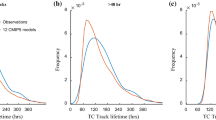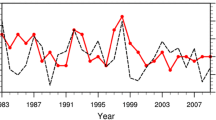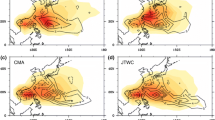Abstract
The sensitivity of tropical cyclone (TC) projection results to different models and the detection and tracking scheme used is well established in the literature. Here, future climate projections of TC activity in the Eastern North Pacific basin (ENP, defined from 0° to 40°N and 180° to ~ 75°W) are assessed with a model- and basin-independent detection and tracking scheme that was trained in reanalysis data. The scheme is applied to models from the Coupled Model Intercomparison Project Phase 5 (CMIP5) experiments forced under the historical and Representative Concentration Pathway 8.5 (RCP8.5) conditions. TC tracks from the observed records and models are analysed simultaneously with a curve-clustering algorithm, allowing observed and model tracks to be projected onto the same set of clusters. The ENP is divided into three clusters, one in the Central North Pacific (CNP) and two off the Mexican coast, as in prior studies. After accounting for model biases and auto-correlation, projection results under RCP8.5 indicated TC genesis to be significantly suppressed east of 125°W, and significantly enhanced west of 145°W by the end of the twenty-first century. Regional TC track exposure was found to significantly increase around Hawaii (~ 86%), as shown in earlier studies, owing to increased TC genesis, particularly to the south-east of the island nation. TC exposure to Southern Mexico was shown to decrease (~ 4%), owing to a south-westward displacement of TCs and overall suppression of genesis near the Mexican coastline. The large-scale environmental conditions most consistent with these projected changes were vertical wind shear and relative humidity.







Similar content being viewed by others
Notes
Most results in this paper are tested for sensitivity or simply given by a mean of six independent models (6-M). However, some statistical significance tests were used to support specific results. These tests were conducted at the 95% level using a binomial distribution under the assumption that each model has an equal chance of simulating either more or less TCs in the future-climate compared to the current-climate. Due to the low number of models (in the 6-M and subgroups) agreement between all models is required to achieve 95% significance.
References
Bell SS, Chand SS, Tory KJ, Turville C (2018a) Statistical assessment of the OWZ tropical cyclone tracking scheme in ERA-Interim. J Climate 31:2217–2232
Bell SS, Chand SS, Tory KJ, Dowdy AJ, Turville C, Ye H (2018b) Projections of Southern hemisphere tropical cyclone track density using CMIP5 models. Climate Dyn. https://doi.org/10.1007/s00382-018-4497-4
Bi D et al (2012) The ACCESS coupled model: description, control climate and evaluation. Aust Meteorol Oceanogr J 63(CMIP5 Special Issue):41–646
Camargo SJ, Robertson AW, Barnston AG, Ghil M (2008) Clustering of eastern North Pacific tropical cyclone tracks: ENSO and MJO effects. Geochem Geophys Geosyst 9:Q06V05. https://doi.org/10.1029/2007gc001861
Chand SS, Tory KJ, Ye H, Walsh KJE (2017) Projected increase in El Niño-driven tropical cyclone frequency in the Pacific. Nat Climate Change 7:123–127. https://doi.org/10.1038/nclimate3181
Christensen JH et al (2013) Climate phenomena and their relevance for future regional climate change. In: Stocker TF et al (eds) Climate Change 2013: the physical science basis. Contribution of Working Group I to the Fifth Assessment Report of the Intergovernmental Panel on Climate Change (IPCC AR5). Cambridge University Press, Cambridge
Collier MA et al (2011) The CSIRO-Mk3.6.0 atmosphere-ocean GCM: participation in CMIP5 and data publication. In: 19th international congress on modelling and simulation, Perth, Australia, 12–16 December 2011. http://mssanz.org.au/modsim2011
Donner LJ et al (2011) The dynamical core, physical parameterizations, and basic simulation characteristics of the atmospheric component AM3 of the GFDL global coupled model CM3. J Climate 24:3484–3519. https://doi.org/10.1175/2011JCLI3955.1
Dunkerton TJ, Montgomery MT, Wang Z (2009) Tropical cyclogenesis in a tropical wave critical layer: easterly waves. Atmos Chem Phys 9:5587–5646
Gaffney SJ (2004) Probabilistic curve-aligned clustering and prediction with regression mixture models. Ph.D. thesis, University of California, Irvine, p 281. http://www.ics.uci.edu/pub/sgaffney/outgoing/sgaffney_thesis.pdf
Gent PR et al (2011) The community climate system model version 4. J Climate Spec Collect 24:4973–4991
Hawkins E, Osbourne TM, Ho CK, Challinor AJ (2013) Calibration and bias correction of climate projections for crop modelling: an idealised case study over Europe. Agric For Meteorol 170:19–31
Ho CK, Stephenson DB, Collins M, Ferro CAT, Brown SJ (2012) A source of additional uncertainty in climate change projections. Bull Am Meteorol Soc 93:20–26. https://doi.org/10.1175/2011BAMS3110.1
Horn M et al (2014) Tracking scheme dependence of simulated tropical cyclone response to idealized climate simulations. J Climate 27:9197–9213. https://doi.org/10.1175/JCLI-D-14-00200.1
Jones CD et al (2011) The HadGEM2-ES implementation of CMIP5 centennial simulations. Geosci Model Dev 4:543–570
Knapp KR, Kruk MC, Levinson DH, Diamond HJ, Neumann CJ (2010a) The International Best Track Archive for Climate Stewardship (IBTrACS) unifying tropical cyclone data. Bull Am Meteorol Soc 91:363–376. https://doi.org/10.1175/2009BAMS2755.1
Knapp KR, Applequist S, Diamond HJ, Kossin JP, Kruk M, Schreck C (2010b) NCDC International Best Track Archive for Climate Stewardship (IBTrACS) Project, version 3. NOAA National Centers for Environmental Information. Subset used: January 1970–December 2016. https://doi.org/10.7289/V5NK3BZP. Accessed 12 Aug 2016
Knutson TR et al (2010) Tropical cyclones and climate change. Nat Geosci 3:157–163
Knutson TR, Sirutis JJ, Zhao M, Tuleya RE, Bende M, Vecchi GA, Villarini G, Chavas D (2015) Global projections of intense tropical cyclone activity for the late 21st century from dynamical downscaling of CMIP5/RCP4.5 scenarios. J Climate. https://doi.org/10.1175/jcli-d-15-0129.1
Knutti R, Masson D, Gettelman A (2013) Climate model genealogy: generation CMIP5 and how we got there. Geophys Res Lett 40:1194–1199
Murakami H, Mizuta R, Shindo E (2012a) Future changes in tropical cyclone activity projected by multi-physics and multi-SST ensemble experiments using the 60-km-mesh MRI-AGCM. Climate Dyn 39:2569–2584
Murakami H et al (2012b) Future changes in tropical cyclone activity projected by the new high-resolution MRI-AGCM. J Climate 25:3237–3260. https://doi.org/10.1175/JCLI-D-11-00415.1
Murakami H, Wang B, Li T, Kitoh A (2013) Projected increase in tropical cyclones near Hawaii. Nat Climate Change 3:749–754. https://doi.org/10.1038/NCLIMATE1890
Murakami H, Hsu P-C, Arakawa O, Li T (2014) Influence of model biases on projected future changes in tropical cyclone frequency of occurrence. J Climate 27:2159–2181. https://doi.org/10.1175/JCLI-D-13-00436.1
Okubo A (1970) Horizontal dispersion of floatable particles in the vicinity of velocity singularities such as convergences. Deep Sea Res 17:445–454
Riahi K, Rao S, Krey V, Cho C, Chirkov V, Fischer G, Kindermann G, Nakicenovic N, Rafai P (2011) RCP 8.5—a scenario of comparatively high greenhouse gas emissions. Clim Change 109:33–57. https://doi.org/10.1007/s10584-011-0149-y
Roberts MJ, Vidale PL, Mizielinski MS, Demory M-E, Schiemann R, Strachan J, Hodges K, Bell R, Camp J (2015) Tropical cyclones in the UPSCALE ensemble of high-resolution global climate models. J Climate 28:574–596
Sanderson B, Knutti R, Caldwell P (2015) A representative democracy to reduce interdependency in a multimodel ensemble. J Climate 28:5171–5194
Sugi M, Murakami H, Yoshida K (2016) Projection of future changes in the frequency of intense tropical cyclones. Climate Dyn 49:619–632
Taylor KE, Stouffer RJ, Meehl GA (2012) An overview of CMIP5 and the experiment design. Bull Am Meteor Soc 93:485–498
Tory KJ, Dare RA (2015) Sea surface temperature thresholds for tropical cyclone formation. J Climate 28:8171–8183. https://doi.org/10.1175/JCLI-D-14-00637.1
Tory KJ, Dare RA, Davidson NE, McBride JL, Chand SS (2013a) The importance of low-deformation vorticity in tropical cyclone formation. Atmos Chem Phys 13:2115–2132. https://doi.org/10.5194/acp-13-2115-2013
Tory KJ, Chand SS, Dare RA, McBride JL (2013b) The development and assessment of a model-, grid-, and basin independent tropical cyclone detection scheme. J Climate 26:5493–5507. https://doi.org/10.1175/JCLI-D-12-00510.1
Tory KJ, Chand SS, McBride JL, Ye H, Dare RA (2013c) Projected changes in late-twenty-first-century tropical cyclone frequency in 13 coupled climate models from phase 5 of the Coupled Model Intercomparison Project. J Climate 26:9946–9959. https://doi.org/10.1175/JCLI-D-13-00010.1
Tory KJ, Ye H, Dare RA (2018) Understanding the geographic distribution of tropical cyclone formation for applications in climate models. Climate Dyn 50:2489–2512. https://doi.org/10.1007/s00382-017-3752-4
Van Vuuren DP et al (2011) The representative concentration pathways: an overview. Clim Change 109:5–31. https://doi.org/10.1007/s10584-011-0148-z
Voldoire A et al (2012) The CNRM-CM5.1 global climate model: description and basic evaluation. Climate Dyn 40:2091–2121
Walsh KJE, McBride JL, Klotzbach PJ, Balachandran S, Camargo SJ, Holland G, Knutson TR, Kossin JP, Lee TC, Sobel A, Sugi M (2016) Tropical cyclones and climate change. WIREs Climate Change 7:65–89. https://doi.org/10.1002/WCC.371
Watanabe M et al (2010) Improved climate simulation by MIROC5: mean states, variability, and climate sensitivity. J Climate 23:6312–6335. https://doi.org/10.1175/2010JCLI3679.1
Weinkle J, Maue R, Pielke R (2012) Historical global tropical cyclone landfalls. J Climate 25:4729–4735. https://doi.org/10.1175/JCLI-D-11-00719.1
Weiss J (1991) The dynamics of enstrophy transfer in two-dimensional hydrodynamics. Phys D 48:273–294
Wu T et al (2014) An overview of BCC climate system model development and application for climate change studies. J Meteorol Res 28:34–56. https://doi.org/10.1007/s13351-014-3041-7
Yoshida K, Sugi M, Mizuta R, Murakami H, Ishii M (2017) Future changes in tropical cyclone activity in high-resolution large-ensemble simulations. Geophys Res Lett 44:9910–9917. https://doi.org/10.1002/2017GL075058
Acknowledgements
This work is supported through funding from the Earth Systems and Climate Change Hub of the Australian Government’s National Environmental Science Programme (NESP). Samuel Bell is supported by an Australian Government Research Training Program (RTP) Stipend and RTP Fee-Offset Scholarship through Federation University Australia.
Author information
Authors and Affiliations
Corresponding author
Additional information
Publisher's Note
Springer Nature remains neutral with regard to jurisdictional claims in published maps and institutional affiliations.
Appendix
Appendix
1.1 OWZ detection and tracking
The OWZ detection system consists of six parameters (Table 6): minimum thresholds of OWZ at the 850- and 500 hPa levels, relative humidity (RH) at the 950- and 700 hPa levels, specific humidity (SpH) at the 950 hPa level and a maximum threshold of vertical wind shear (VWS) between 850- and 200 hPa. The OWZ variable is a low deformation vorticity parameter used to identify regions favourable for TC formation at the centre of a semi-closed circulation (i.e. a ‘marsupial pouch’; Dunkerton et al. 2009), within the lower- to mid-troposphere. More precisely, it is the product of absolute vorticity and the Okubo-Weiss parameter (Okubo 1970; Weiss 1991) normalised by the vertical component of relative vorticity squared such that:
where \(f\) is the Coriolis parameter, \(\zeta = \frac{\partial v}{\partial x} - \frac{\partial u}{\partial y}\) the vertical component of relative vorticity, \(E = \frac{\partial u}{\partial x} - \frac{\partial v}{\partial y}\) the stretching deformation, and \(F = \frac{\partial v}{\partial x} + \frac{\partial u}{\partial y}\) the shearing deformation.
The OWZ detection and tracking scheme is concisely summarized in five dot points below, with further detail accessible in other studies (Tory et al. 2013a; Bell et al. 2018a).
-
(a)
Each 1º × 1º grid point is assessed based on the initial threshold values of each OWZ-detector parameter every 12-h.
-
(b)
When at least two neighbouring grid points satisfy the initial thresholds of each OWZ-detector parameter, these points are considered to represent a single circulation at that point in time.
-
(c)
The circulations from step (b) are linked through time by estimating their position in relation to the circulation’s expected position based on an averaged 4º × 4º steering wind at 700 hPa.
-
(d)
Tracks are terminated when no circulation match is found in the next two time-steps within a generous (~ 350 km) latitude dependent radius.
-
(e)
The core thresholds are then applied to each storm track, and if they are satisfied for 48-h, a TC is declared.
Rights and permissions
About this article
Cite this article
Bell, S.S., Chand, S.S., Tory, K.J. et al. Eastern North Pacific tropical cyclone activity in historical and future CMIP5 experiments: assessment with a model-independent tracking scheme. Clim Dyn 53, 4841–4855 (2019). https://doi.org/10.1007/s00382-019-04830-0
Received:
Accepted:
Published:
Issue Date:
DOI: https://doi.org/10.1007/s00382-019-04830-0




